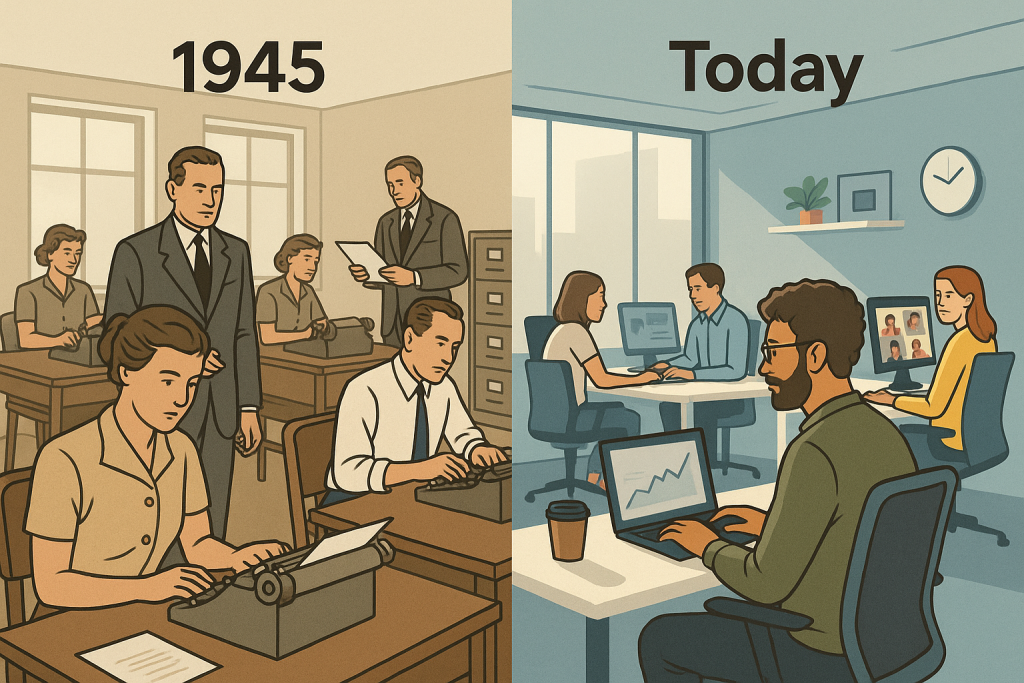On 8 May 1945, the United Kingdom joined the world in celebrating Victory in Europe Day—VE Day—marking the end of the Second World War in Europe. As soldiers returned home and society turned its focus to rebuilding, the workplace became central to economic renewal. Since then, the traditional office has undergone a dramatic transformation—from clacking typewriters and strict dress codes to remote logins, hybrid schedules and smart software tools like Accordant. Let’s take a look at just how much the workplace has changed since that historic day.

The Post-War Office: Order, Hierarchy and Typewriters
In 1945, the typical office environment was formal and hierarchical. Rows of desks were occupied by clerks, typists and secretaries, often working with manual typewriters, carbon paper and towering filing cabinets. Communication was paper-based and largely dictated by the chain of command. Private offices were reserved for senior management, while junior staff worked in open-plan “bullpen” areas under close supervision.
Smoking indoors was commonplace, women’s roles were primarily secretarial, and the concept of work-life balance was virtually unheard of. The post-war office reflected the values of the time: discipline, order and lifelong loyalty to one’s employer.
The 1960s–70s: The Age of Cubicles and Electric Innovation
With the growth of multinational corporations came a need for greater efficiency and structure. The 1960s saw the introduction of electric typewriters, photocopiers and the earliest computers. Office layout evolved too, with the introduction of the cubicle in the late ’60s—initially designed to offer flexibility and privacy, but eventually criticised for fostering isolation and monotony.
The feminist movement began to reshape the office, with more women entering professional and administrative roles. Dress codes relaxed slightly, and the notion of “career ladders” began to take root for a broader range of employees.
The 1980s–90s: The Digital Shift and the Rise of Corporate Culture
The 1980s marked the arrival of desktop computing. Programmes like Microsoft Word and Excel revolutionised how work was done, while the fax machine sped up business communication. Offices remained centralised but were increasingly wired with technology. Email started to replace memos and post, and companies invested in IT departments to manage this new infrastructure.
The 1990s saw the early days of the internet in the workplace. It also ushered in “casual Friday”, the beginnings of flexible working, and a move towards more team-oriented office layouts.
The 2000s: Dot-Com Culture and the Open Office
In the early 2000s, the dot-com boom inspired a new breed of open-plan offices. Start-ups and tech firms led the charge with ping-pong tables, casual attire and flat organisational structures. Instant messaging tools, high-speed internet and mobile phones enabled constant connectivity. Email was king.
Work began to spill beyond the traditional 9–5 as laptops and smartphones allowed people to stay connected from anywhere. While this increased productivity, it also blurred the lines between work and personal life.
The 2010s: Flexibility, Coworking and a Mobile Workforce
The 2010s brought even greater mobility. Cloud computing, remote access tools and collaborative platforms like Slack and Google Workspace made it possible to work from virtually anywhere. Coworking spaces such as WeWork became popular among freelancers, start-ups and remote teams.
This decade also brought greater emphasis on mental health, employee wellbeing and inclusive workplace cultures. Companies began focusing not just on productivity, but on fostering healthy and engaging work environments.
2020 and Beyond: Hybrid Work and the Post-Pandemic Office
The COVID-19 pandemic triggered a sudden and massive shift to remote work. Offices were replaced by kitchen tables, and video conferencing tools like Zoom became indispensable. What was initially a crisis response has become a long-term evolution: the hybrid office.
Now, many organisations offer employees the flexibility to split time between home and office. This has prompted a rethink of office design—less about desks for every employee, more about spaces for collaboration and creativity.
Managing the Modern Workplace with Tools Like Accordant
In this new era of hybrid working, digital tools have become essential for managing office spaces effectively. One such tool is Accordant, a workplace management platform that helps organisations adapt their spaces to evolving needs.
Accordant enables facilities managers and HR teams to visualise office layouts, monitor occupancy, manage moves, and plan for future growth—all through an intuitive digital interface. It provides real-time data on desk usage, meeting room availability and space efficiency, making it easier to make informed decisions about downsizing, expansion or redesign.
In a hybrid workplace where employees may be in the office only a few days a week, tools like Accordant are invaluable for ensuring the right balance between flexibility and functionality. It supports agile work strategies, hot-desking, and improved collaboration—all while helping to reduce costs and environmental impact.
Conclusion: From Rows of Desks to Responsive Workspaces
Since VE Day, the office has evolved from a rigid, hierarchical space to a flexible and adaptive environment. While the tools, norms and expectations have changed dramatically, the workplace remains a mirror of broader societal trends—whether it’s gender roles, technology, or work-life integration.
As we look to the future, platforms like Accordant offer a way to navigate this evolving landscape—ensuring that offices remain efficient, sustainable and human-centric spaces, no matter where or how we work.